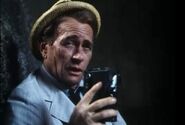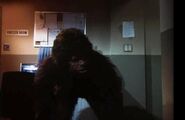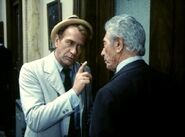- "During World War II, close to this very spot, science bore a child that changed the course of human relations. And to this day threatens to end human history. It was called, innocuously enough, the Manhattan Project. And it grew into the terror we all have come to know as the hydrogen bomb. But this year, only a stone's throw from here, science delivered a new child..."
- ―Carl Kolchak
| "Primal Scream" | |
|---|---|

| |
| Air date | January 17th, 1975 |
| Writers | Bill S. Ballinger; David Chase |
| Director | Robert Scheerer |
| Producers | Cy Chermak |
| Starring | Darren McGavin; Simon Oakland |
| Episode guide | |
| Previous "Mr. R.I.N.G." |
Next "The Trevi Collection" |
"Primal Scream" is the thirteenth episode of the supernatural mystery series Kolchak: The Night Stalker. It was directed by Robert Scheerer and written by Bill S. Ballinger and David Chase. It first aired on ABC on January 17th, 1975. In this episode, Carl Kolchak investigates the murder of Doctor Jules Copenik, a biologist for a multi-billion dollar oil drilling corporation. After learning that the man was savagely beaten to death with his arm torn out of his socket, Kolchak doggedly pursues the case, only to be railroaded by police captain Maurice Molnar. Several more similar murders take place and Kolchak discovers that the assailant is a neolithic ape man that had grown from fertile cells found within a block of ice. Kolchak pursues the creature into a series of underground tunnels where he has his final and deadly showdown.
Synopsis
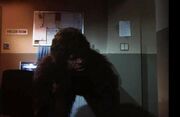
The ape man goes berserk!
November 8th, 1975. At the Oceanic International Oil Corporation, experimental biologist Jules Copenik enters his laboratory. After turning on the lights, he is suddenly assaulted by a strange, savage ape man that emerges from the freezer room.
Carl Kolchak is called in to investigate the murder of Doctor Copenik. At the crime scene, he consults with Captain Maurice Molnar, who has little tolerance for reporters and doesn't care for Kolchak very much at all. He yields very little information save that Copenikwas bludgeoned to death and that his arm had been torn out of its socket and is still missing. The police have no suspects at this time.
After cutting through a sizeable amount of red tape, Kolchak finally manages to land an interview with Thomas J. Kitzmiller, the vice president in charge of public relations. Kitzmiller is very quick to point out OIO's positive attributes and indicates that Doctor Copenik was just a biologist and certainly not a potential target of anyone who might have a gripe with the oil industry. Kolchak probes further and learns Copenik and his partner, Doctor Helen Lynch, had studied some core samples taken from the Arctic, which they believed to hold preserved single-cell life forms. Kolchak asks where he can reach Doctor Lynch, but Kitzmiller tells him that she was involved in a car accident and is in no condition to see anyone.
Kolchak is undeterred however. After a quick stop at the office, Carl decides to go see Doctor Helen Lynch. He tries to visit her at the hospital, but the doctor refuses to allow him admittance, stating that Helen has already been through a lot and that she is not to be disturbed. Kolchak feigns leaving the hospital, but offers to carry a woman's potted plant, which obscures his face, thus allowing him to get into Lynch's room.
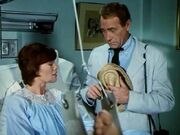
Kolchak interviews Helen Lynch.
Helen is exhausted and really doesn't wish to speak on Copenik's death any further, but Kolchak presses the issue and she tells him about their research. She reveals that their science team recovered preserved traces of skin cells within a block of ice and brought it back to the lab. They were surprised that the cells were still active, even though they may have been thousands, even millions of years old. Carl knows that the freezer unit in Doctor Copenik's lab had failed and he wondered if the samples may have grown into a living animal upon thawing. The Doctor finally finds Kolchak in Lynch's room and has his orderlies remove him from the hospital.
In another part of the city, a photographer named Robert Gurney returns home. As he pours himself a drink and watches some television, the bizarre ape creature springs through his window and murders him.
On his way back from a press junket in Springfield, Carl responds to the crime scene. His colleague Ron Updyke got there before him however and tells Carl that Gurney was murdered by a gorilla that the police now have in custody. Carl is flabbergasted and has difficulty believing the story. Kolchak wonders if Gurney may have had a connection to OIO. He goes to speak with an upstairs neighbor who tells him about the strange noises she heard coming from Gurney's studio.
He goes back to the Oceanic International Oil Corporation offices to see Kitzmiller, but his secretary just gives him the runaround, stating that Kitzmiller is too busy with meetings and cannot see him. He then speaks with Captain Molnar who roadblocks his efforts yet again.
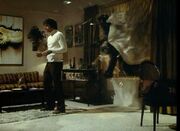
The beast attacks Robert Gurney.
November 10th, Grinnell Avenue: The ape man breaks free of his constraints and attacks and kills a meat market delivery driver named William Pratt. Kolchak arrives on the scene as the creature is fleeing and manages to snap a photograph. The animal pushes past him and Carl realizes that this is not a gorilla as the police had claimed. Police officers are in pursuit, but the ape man gets away. Kolchak tells Captain Molnar about what he had seen and reveals that he even managed to get a picture of the creature. Captain Molnar "accidentally" breaks Kolchak's camera.
The creature claims his next victim the very next night. Rosetta Mason walks by Chin's Market at 828 Marquette Street at 9:30 pm when the animal pounces upon her. The police had no leads, but the creature did leave behind an ominous footprint. Carl takes a photograph of the footprint and brings it to a high school biology teacher named Jack Burton. Burton gives Kolchak a crash course in anthropology, but he does confirm that the being responsible for leaving such a footprint was unlike anything he had ever seen before.
Armed with the information supplied by Burton, Kolchak deduces that the creature would seek out a dark and warm environment in which to feel safe, like a cave. As there are no caves in Chicago, Carl decides to try searching for it in the old underground tunnels that ran beneath what used to be Chicago Stadium. Kolchak scours the dark tunnels, lighting flares along the way, hoping to bring the man ape out of hiding. The creature emerges and attacks him, clawing at Kolchak's face. Police officers arrive on the scene just in time to take it down with a series of tranquilizer darts. As they take it away, Carl speaks into his pocket recorder about the events that had just transpired. He believes that this ape man will be taken away to some secret laboratory somewhere where it will be experimented on.
Cast
Principal Cast
| Actor | Role |
|---|---|
| Darren McGavin | Carl Kolchak |
| Simon Oakland | Tony Vincenzo |
Guest Stars
| Actor | Role |
|---|---|
| John Marley | Captain Maurice Molnar |
| Pat Harrington, Jr. | Thomas J. Kitzmiller |
| Katherine Woodville | Doctor Helen Lynch |
| Jamie Farr | Jack Burton |
| Jack Grinnage | Ron Updyke |
| Barbara Rhoades | The secretary |
| Jeannie Bell | Rosetta Mason |
| C. Lindsay Workman | Doctor Fisk |
| Regis Cordic | Doctor Peel |
| Byron Morrow | Doctor Cowan |
| Vince Howard | Policeman |
| Sandra Gould | Landlady |
| Al Checco | Nils |
| Craig R. Baxley | Robert Gurney |
| Gary Baxley | Ape man |
| Paul Baxley | Doctor Jules Copenik |
| Creed Bratton | Man entering lab |
| Barbara Luddy | Neighbor |
| Paul Picerni | Humane society man |
| Chuck Waters | William Pratt |
| Arnold Williams | Barney |
Notes & Trivia
- This episode is included on disc four of the Classic Television: Kolchak: The Night Stalker DVD collection.
- The episode opens with the closing scene and the rest of the story is revealed in flashback.
- This is the only episode of Kolchak: The Night Stalker directed by Robert Scheerer. He is also known for directing episodes of the popular sci-fi television programs Star Trek: The Next Generation and Star Trek: Voyager, among many others.
- This is the second episode of Kolchak: The Night Stalker written by Bill S. Ballinger. He also wrote "Firefall".
- This is the fifth episode of Kolchak: The Night Stalker written by David Chase. He previously wrote "The Spanish Moss Murders". His next episode is "Chopper".
- William Pratt is also the real name of legendary Universal Horror actor Boris Karloff, who has appeared in such films as Frankenstein, The Bride of Frankenstein, Abbott and Costello Meet the Killer, Boris Karloff, The Strange Door and Isle of the Snake People. It is also the real name of Spike, a vampire character featured in the WB Network television series Buffy the Vampire Slayer and it's spin-off series, Angel.
- The Robert Gurney murder takes place two days after the Copenik murder.
- This is the twelfth episode of Kolchak: The Night Stalker with Paul Baxley as a stunt coordinator. It is his fourth episode on the show as an actor. He previously played an electrocuted worker in "The Energy Eater". His next appearance is that of Rolf Danvers in "The Knightly Murders".
Allusions
- In the opening narration, Carl Kolchak makes reference to the Manhattan Project. The Manhattan Project was a research and development program by the United States with the United Kingdom and Canada that produced the first atomic bomb during World War II.
- Kolchak's line, "You see, some of our biggest headaches have come from vice presidents." is likely a veiled allusion to Richard M. Nixon who, in addition to serving as the 37th president of the United States, also served as vice president under Dwight D. Eisenhower.
- Kolchak makes several references to the 1970s energy crisis. This was a period in which the major industrial countries of the world, particularly the United States, faced substantial shortages, both perceived and real, of petroleum.
- Tony Vincenzo pokes fun at Kolchak's tardy reporting by asking him if he is going to cover something hot like the Lincoln/Douglas debates. This is a reference to the infamous Illinois state senate debates of 1858 between Democratic candidate Stephen Douglas and Republican candidate and future US president Abraham Lincoln.
Cast
- Actor Jamie Farr is credited as a special guest star in this episode. Farr only has a brief scene as high school biology teacher Jack Burton. Farr is best known for playing the role of Sergeant Maxwell Q. Klinger, the cross-dressing Army officer from the popular 1970s sitcom M*A*S*H*.
- Stuntman Gary Baxley, who plays the ape man, is the nephew of Paul Baxley who plays Gary's first victim, Doctor Jules Copenik.
- Pat Harrington, Jr. is credited as Pat Harrington in this episode.
- Katherine Woodville is credited as Katharine Woodville in this episode.
- Jeannie Bell is credited as Jeanie Bell in this episode.
- C. Lindsay Workman is credited as Lindsay Workman in this episode.
- Actors Craig R. Baxley, Gary Baxley, Paul Baxley, Creed Bratton, Barbara Luddy, Paul Picerni, Chuck Waters and Arnold Williams are all uncredited for their participation in this episode.
This Day in History
- 1922: Actress Betty White is born in Oak Park, Illinois
- 1942: Actress Nancy Parsons is born in St. Paul, Minnesota.
- 1944: Black Christmas screenwriter Roy Moore is born in London, Ontario, Canada.
- 1953: Director Mark Jones is born in Los Angeles, California.
- 1961: Thriller episode "Man in the Cage" airs on NBC.
- 1971: Lust for a Vampire premieres in the UK.
- 1972: Actress Rochelle Hudson passes away in Palm Desert, California.
- 1975: Kolchak: The Night Stalker episode "Primal Scream" airs on ABC.
- 1977: Actor Leigh Whannell is born in Victoria, Australia.
- 1979: Nosferatu, The Vampyre premieres in France.
- 1993: Production on Needful Things concludes.
- 1996: Carnosaur 3: Primal Species is released direct-to-video.
- 1996: American Gothic episode "Inhumanitas" airs on CBS.
- 2000: Principal photography on Scary Movie concludes.
- 2002: Charmed episode "A Paige from the Past" airs on the WB Network.
- 2004: Actor Noble Willingham passes away in Palm Springs, California.
- 2004: Haute tension is screened at the Sundance Film Festival under the title High Tension.
- 2006: Puppet Master vs. Demonic Toys is released on DVD in Region 1 format in North America.
- 2006: Supernatural episode "Faith" airs on the CW Network.
- 2006: Ghost in the Machine is released on DVD in Region 1 format.
- 2009: Fear Itself episode "The Spirit Box" airs on NBC.
- 2011: Being Human (US) episode "There Goes the Neighborhood (Part 1)" airs on Syfy and the Space Channel.
- 2012: 2-Headed Shark Attack is released direct-to-video in the United States.
- 2014: Devil's Due premieres theatrically in the United States.
- 2014: The Babadook is first screened at the Sundance Film Festival.
- 2017: Ouija: Origin of Evil is released on DVD and Blu-ray by Universal Pictures Home Entertainment.
- 2017: Resident Evil: Afterlife is released on Blu-ray by Sony Pictures Home Entertainment.
Quotes
- Carl Kolchak: During World War II, close to this very spot, science bore a child that changed the course of human relations. And to this day threatens to end human history. It was called, innocuously enough, the Manhattan Project. And it grew into the terror we all have come to know as the hydrogen bomb. But this year, only a stone's throw from here, science delivered a new child...
....
- Tony Vincenzo: You know, there are times I got to admit it, Carl. You are quite a reporter.
- Carl Kolchak: What's the matter with you, Tony? Are you sick or something? You never compliment me.
....
- Ron Updyke: Good-bye, Carl. Don't take any wooden bananas.
- Carl Kolchak: That was bad, Ron. That was very bad.
....
- Carl Kolchak: It gets so frozen, so stiff up there that even the penguins wear thermal underwear.
....
- Carl Kolchak: Ever try to deal with a giant corporation? They transfer your call here. They transfer it there. And they put you on hold. You're out in the cold. Oceanic International Oil was all that and more.
....
- Carl Kolchak: What is this, a freezer?
- Captain Molnar: Well, what does it look like?
- Carl Kolchak: Well, it looks like a freezer. But it's so hot and damp and humid in here, you could steam littleneck clams.
- Captain Molnar: Well, it's out of order.
- Carl Kolchak: Yeah, it stinks too. It smells of mildew. Phew!
- Captain Molnar: Maybe it's your undershirt.
- Carl Kolchak: Could be your jokes.
....
- Carl Kolchak: If it's really an ape, why are you investigating it? Why are you on the case?
- Captain Molnar: I have the experience. I've had a lot of dealings with baboons.
- Carl Kolchak: Whattya mean baboons?!?
....
- Carl Kolchak: Hey, Tony! What's new?
- Tony Vincenzo: That's why I've got reporters... to tell me what's new!
....
- Tony Vincenzo: Now where are you going, Carl?
- Carl Kolchak: Springfield.
- Tony Vincenzo: To cover some hot news like the Lincoln/Douglas debate?
....
- Carl Kolchak: Now you saw that thing and I saw it, and that was not just any ape. I mean, that wasn't just J. Fred Muggs out there, dressed in a tutu and drooling for the public and playing on a unicycle. That was some... creature!
....
- Carl Kolchak: You see, some of our biggest headaches have come from vice presidents.
....
- Carl Kolchak: The police and the high-priced scientific help put it together just as I did. With the proper dosage of tranquilizer, the creature became... manageable. That's a great word, isn't it? Manageable. They took it, or should I say him, a few moments ago. He's gonna be tested, studied, probed, I imagine. Captain Molnar took my camera... again, saying that I was unmanageable. But I wanna sue to get it back, and I promised myself that. And if I do, and I do get it back, and if Vincenzo will publish the story, and you see the pictures, they may not be too good. They may be blurry. They may be titilating and not convincing. You might not really want to believe them. But you go ahead. You believe them. And ask yourself, "What happened to him, to it? Will he thrive in our hands? Is he that much like us? Will they be able to make him... manageable?


